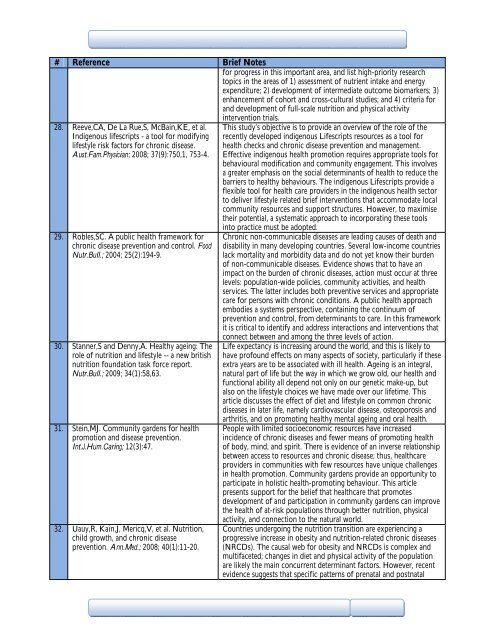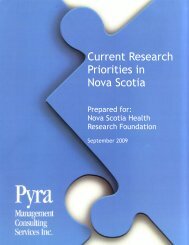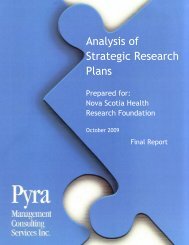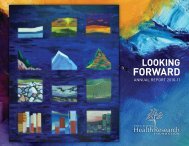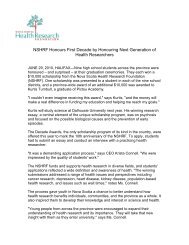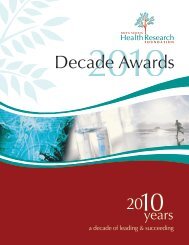Major Health Issues in Nova Scotia: An Environmental Scan
Major Health Issues in Nova Scotia: An Environmental Scan
Major Health Issues in Nova Scotia: An Environmental Scan
Create successful ePaper yourself
Turn your PDF publications into a flip-book with our unique Google optimized e-Paper software.
# Reference Brief Notes<br />
for progress <strong>in</strong> this important area, and list high-priority research<br />
topics <strong>in</strong> the areas of 1) assessment of nutrient <strong>in</strong>take and energy<br />
expenditure; 2) development of <strong>in</strong>termediate outcome biomarkers; 3)<br />
enhancement of cohort and cross-cultural studies; and 4) criteria for<br />
and development of full-scale nutrition and physical activity<br />
<strong>in</strong>tervention trials.<br />
28. Reeve,CA, De La Rue,S, McBa<strong>in</strong>,KE, et al.<br />
Indigenous lifescripts - a tool for modify<strong>in</strong>g<br />
lifestyle risk factors for chronic disease.<br />
Aust.Fam.Physician; 2008; 37(9):750,1, 753-4.<br />
29. Robles,SC. A public health framework for<br />
chronic disease prevention and control. Food<br />
Nutr.Bull.; 2004; 25(2):194-9.<br />
30. Stanner,S and Denny,A. <strong>Health</strong>y age<strong>in</strong>g: The<br />
role of nutrition and lifestyle -- a new british<br />
nutrition foundation task force report.<br />
Nutr.Bull.; 2009; 34(1):58,63.<br />
31. Ste<strong>in</strong>,MJ. Community gardens for health<br />
promotion and disease prevention.<br />
Int.J.Hum.Car<strong>in</strong>g; 12(3):47.<br />
32. Uauy,R, Ka<strong>in</strong>,J, Mericq,V, et al. Nutrition,<br />
child growth, and chronic disease<br />
prevention. <strong>An</strong>n.Med.; 2008; 40(1):11-20.<br />
This study’s objective is to provide an overview of the role of the<br />
recently developed <strong>in</strong>digenous Lifescripts resources as a tool for<br />
health checks and chronic disease prevention and management.<br />
Effective <strong>in</strong>digenous health promotion requires appropriate tools for<br />
behavioural modification and community engagement. This <strong>in</strong>volves<br />
a greater emphasis on the social determ<strong>in</strong>ants of health to reduce the<br />
barriers to healthy behaviours. The <strong>in</strong>digenous Lifescripts provide a<br />
flexible tool for health care providers <strong>in</strong> the <strong>in</strong>digenous health sector<br />
to deliver lifestyle related brief <strong>in</strong>terventions that accommodate local<br />
community resources and support structures. However, to maximise<br />
their potential, a systematic approach to <strong>in</strong>corporat<strong>in</strong>g these tools<br />
<strong>in</strong>to practice must be adopted.<br />
Chronic non-communicable diseases are lead<strong>in</strong>g causes of death and<br />
disability <strong>in</strong> many develop<strong>in</strong>g countries. Several low-<strong>in</strong>come countries<br />
lack mortality and morbidity data and do not yet know their burden<br />
of non-communicable diseases. Evidence shows that to have an<br />
impact on the burden of chronic diseases, action must occur at three<br />
levels: population-wide policies, community activities, and health<br />
services. The latter <strong>in</strong>cludes both preventive services and appropriate<br />
care for persons with chronic conditions. A public health approach<br />
embodies a systems perspective, conta<strong>in</strong><strong>in</strong>g the cont<strong>in</strong>uum of<br />
prevention and control, from determ<strong>in</strong>ants to care. In this framework<br />
it is critical to identify and address <strong>in</strong>teractions and <strong>in</strong>terventions that<br />
connect between and among the three levels of action.<br />
Life expectancy is <strong>in</strong>creas<strong>in</strong>g around the world, and this is likely to<br />
have profound effects on many aspects of society, particularly if these<br />
extra years are to be associated with ill health. Age<strong>in</strong>g is an <strong>in</strong>tegral,<br />
natural part of life but the way <strong>in</strong> which we grow old, our health and<br />
functional ability all depend not only on our genetic make-up, but<br />
also on the lifestyle choices we have made over our lifetime. This<br />
article discusses the effect of diet and lifestyle on common chronic<br />
diseases <strong>in</strong> later life, namely cardiovascular disease, osteoporosis and<br />
arthritis, and on promot<strong>in</strong>g healthy mental age<strong>in</strong>g and oral health.<br />
People with limited socioeconomic resources have <strong>in</strong>creased<br />
<strong>in</strong>cidence of chronic diseases and fewer means of promot<strong>in</strong>g health<br />
of body, m<strong>in</strong>d, and spirit. There is evidence of an <strong>in</strong>verse relationship<br />
between access to resources and chronic disease; thus, healthcare<br />
providers <strong>in</strong> communities with few resources have unique challenges<br />
<strong>in</strong> health promotion. Community gardens provide an opportunity to<br />
participate <strong>in</strong> holistic health-promot<strong>in</strong>g behaviour. This article<br />
presents support for the belief that healthcare that promotes<br />
development of and participation <strong>in</strong> community gardens can improve<br />
the health of at-risk populations through better nutrition, physical<br />
activity, and connection to the natural world.<br />
Countries undergo<strong>in</strong>g the nutrition transition are experienc<strong>in</strong>g a<br />
progressive <strong>in</strong>crease <strong>in</strong> obesity and nutrition-related chronic diseases<br />
(NRCDs). The causal web for obesity and NRCDs is complex and<br />
multifaceted; changes <strong>in</strong> diet and physical activity of the population<br />
are likely the ma<strong>in</strong> concurrent determ<strong>in</strong>ant factors. However, recent<br />
evidence suggests that specific patterns of prenatal and postnatal


